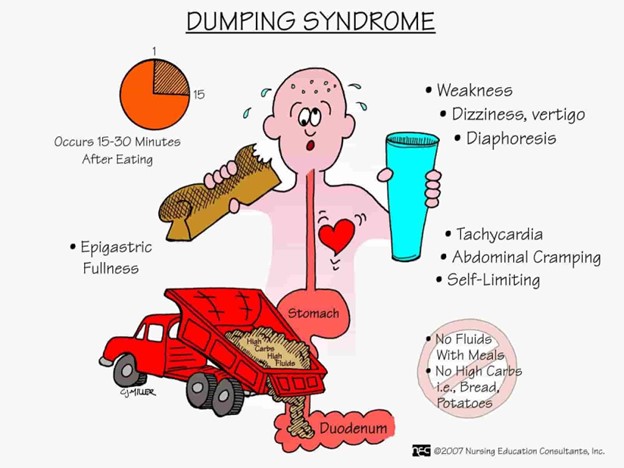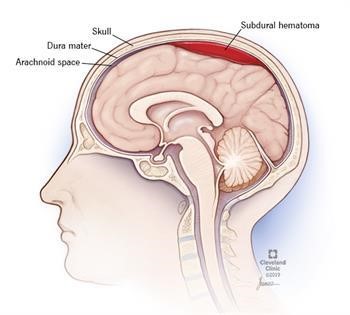The nurse is monitoring a client for the early signs and symptoms of dumping syndrome. Which findings indicate this occurrence?
Sweating and pallor
Abdominal cramping and pain
Double vision and chest pain
Bradycardia and indigestion
The Correct Answer is A
Choice A Reason: Sweating and pallor are early signs and symptoms of dumping syndrome, which is a condition where food moves too quickly from the stomach to the small intestine, causing rapid fluid shifts and hormonal changes. Sweating and pallor are caused by hypoglycemia, which occurs when the high concentration of food in the small intestine stimulates insulin secretion.
Choice B Reason: Abdominal cramping and pain are late signs and symptoms of dumping syndrome, which occur about one to three hours after eating. Abdominal cramping and pain are caused by intestinal distension, spasms, and gas formation.
Choice C Reason: Double vision and chest pain are not signs and symptoms of dumping syndrome, but may indicate other serious conditions, such as stroke or heart attack. Double vision and chest pain should be reported to the provider immediately.
Choice D Reason: Bradycardia and indigestion are not signs and symptoms of dumping syndrome, but may be related to other gastrointestinal disorders, such as gastritis or peptic ulcer disease. Bradycardia and indigestion should be evaluated by the provider for further diagnosis and treatment.

Nursing Test Bank
Naxlex Comprehensive Predictor Exams
Related Questions
Correct Answer is ["B","D","F"]
Explanation
Choice A Reason: Slow even breathing is not a sign of Cushing's Triad, which is a late indicator of increased intracranial pressure (ICP). The breathing pattern may be altered due to brainstem compression, but not necessarily slow or even.
Choice B Reason: This is a correct answer because bradycardia and bounding pulse are part of Cushing's Triad, which reflects an increased vagal tone and decreased cardiac output due to increased ICP.
Choice C Reason: Systolic hypotension with a narrowing pulse pressure is not a sign of Cushing's Triad, which involves an increased systolic blood pressure and a widened pulse pressure due to increased ICP. Hypotension may occur due to shock or hemorrhage, but not as a result of increased ICP.
Choice D Reason: This is a correct answer because irregular respirations are part of Cushing's Triad, which reflects impaired respiratory control due to brainstem compression from increased ICP. The respirations may be Cheyne-Stokes, central neurogenic hyperventilation, apneustic, or ataxic.
Choice E Reason: Tachycardia and bounding pulse are not signs of Cushing's Triad, which involves bradycardia and bounding pulse due to increased ICP. Tachycardia may occur due to pain, anxiety, fever, or hypoxia, but not as a result of increased ICP.
Choice F Reason: This is a correct answer because systolic hypertension with a widening pulse pressure are part of Cushing's Triad, which reflects an increased cerebral perfusion pressure due to increased ICP. The diastolic blood pressure remains stable or decreases, resulting in a widened pulse pressure.

Correct Answer is C
Explanation
Choice A reason: This is incorrect because acute hemorrhagic stroke is not consistent with these observations. Acute hemorrhagic stroke is a sudden bleeding in the brain that can cause severe neurological deficits, such as paralysis, aphasia, or coma. It does not cause tremors, slowness, or mask-like facial expressions.
Choice B reason: This is incorrect because Alzheimer's disease is not consistent with these observations. Alzheimer's disease is a progressive degeneration of the brain that causes cognitive impairment, memory loss, and behavioral changes. It does not cause tremors, slowness, or mask-like facial expressions.
Choice C reason: This is the correct answer because Parkinson's disease is consistent with these observations. Parkinson's disease is a chronic disorder of the brain that affects movement and coordination. It causes tremors, slowness, rigidity, and postural instability, as well as mask-like facial expressions due to reduced facial muscle activity.
Choice D reason: This is incorrect because traumatic brain injury is not consistent with these observations. Traumatic brain injury is damage to the brain caused by external force, such as a blow, fall, or penetration. It can cause various neurological symptoms depending on the location and severity of the injury, but it does not typically cause tremors, slowness, or mask-like facial expressions.
Whether you are a student looking to ace your exams or a practicing nurse seeking to enhance your expertise , our nursing education contents will empower you with the confidence and competence to make a difference in the lives of patients and become a respected leader in the healthcare field.
Visit Naxlex, invest in your future and unlock endless possibilities with our unparalleled nursing education contents today
Report Wrong Answer on the Current Question
Do you disagree with the answer? If yes, what is your expected answer? Explain.
Kindly be descriptive with the issue you are facing.
